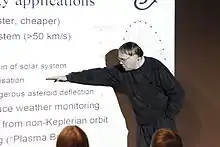Pekka Janhunen
Pekka Janhunen is a space physicist, astrobiologist, and inventor. Janhunen, Ph.D., is a Research Manager at Finnish Meteorological Institute's Space and Earth Observation Centre, and a visiting professor at University of Tartu, Estonia. He is also senior technical advisor at Aurora Propulsion Technologies, a startup company, operating in space sector. He studied theoretical physics at the University of Helsinki, and made his PhD on space plasma physics simulations in 1994. He has also published a theory on the origin of multicellular life. He is best known for his Electric Solar Wind Sail invention.[1][2]

Research
The Electric Sail
The Electric Sail could enable travelling at speeds up to 100 km/s in space without any fuel consumption. With no major problems in any of the technical fields thus far, the planning of the first test mission has started, according to an article by Sciencedaily.[3] In the same article, Sciencedaily wrote that "the electric solar wind sail developed by Dr. Pekka Janhunen might revolutionise travelling in space." Janhunen received funding for his electric solar wind sail research from Runar Bäckström foundation in 2005.
Steam balloons as rocket launch pads
Janhunen has proposed that steam balloons could be used to launch rockets and satellites from higher altitudes. According to Janhunen Steam balloons are a cost-effective way of lifting a rocket into the stratosphere. The method is considered to be safe as well as reducing the carbon footprint of future rocket launches, where as in the past the emissions alone had terrible implications for the climate.[4]
Natural illumination solution for rotating space settlements
Janhunen has proposed a lighting solution for an O'Neill Cylinder. In Janhunen's concept sunlight is concentrated by cylindrical paraboloid concentrators and reflected by semi-toroidal and conical reflectors and controlled by local blinders to simulate earthlike diurnal and seasonal illumination cycles. The rural wall living cylinder is divided into 20 z-directed valleys which are in different phases of the light cycles. No moving parts are needed other than numerous and easily accessible local blinders that regulate light input into the valleys. The settlement rotates as a rigid body and the mass distribution is such that the rotation is passively stable.[5]
Shielded Dumbbell L5 Settlement
A two-sphere dumbbell configuration design of a rotating settlement for a first-generation in-space habitat settlement. According to Janhunen the two-sphere configuration is chosen to minimize the radiation shielding mass which dominates the mass budget.[6]
Other research
Pekka Janhunen has mainly focused on planetary science. Some of the advances he has made in the field include "A three-dimensional stabilization mechanism for the auroral Farley-Buneman instability" and the suggestion to use electromagnetic ionosphere in global magnetohydrodynamic simulations
References
- "A web-page about the electric solar wind sail by Pekka Janhunen". Retrieved 2008-04-18. Also published in Ann. Geophys., 25, 755-767, 2007
- "The grants awarded by Runar Bäckström foundation in 2005".
- "A three-dimensional stabilization mechanism for the auroral Farley-Buneman instability". Also in J. Atmos. Terr. Phys., 54, 1633–1643, 1992.
- "Abstract of the "On the possibility of using an electromagnetic ionosphere in global MHD simulations". Also in Ann. Geophys., 16, 397-402, 1998.
- Asteroid touring nanosat fleet with single-tether E-sails, P. Janhunen, P. Toivanen, J. Envall, K. Muinonen, A. Slavinskis, J. Gonzalez del Amo, Proceedings of the European Planetary Science Congress, 2017.
Footnotes
- "Pekka Janhunen". 2020-05-01. Retrieved 2020-05-01.
- "About us". 2020-05-01. Retrieved 2020-05-01.
- "Electric Solar Wind Sail Could Power Future Space Travel In Solar System". ScienceDaily. 2008-04-17. Retrieved 2008-10-15.
- "Steam balloons could be used to launch satellites". ScitechEuropa. 2019-08-22. Retrieved 2020-01-11.
- "Natural illumination solution for rotating space settlements" (PDF). 2018-09-01. Retrieved 2020-01-11.
- "A design for a first-generation in-space habitat settlement affordable at launch costs of $300/kg is proposed by Pekka Janhunen of the Finnish Meteorological Institute in Helsinki". 2020-04-15. Retrieved 2020-04-19.